Latest Water
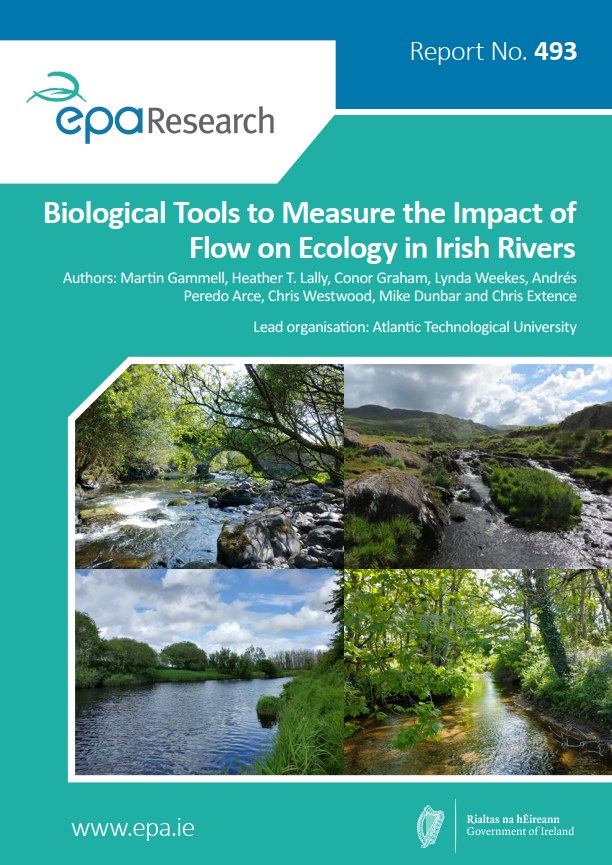
Research 493: Biological Tools to Measure the Impact of Flow on Ecology in Irish Rivers
Authors: Martin Gammell, Heather T. Lally, Conor Graham, Lynda Weekes, Andrés Peredo Arce, Chris Westwood, Mike Dunbar and Chris Extence, September 2025
Year: 2025
Researchers from Atlantic Technological University, examined the use of biomonitoring tools (called hydroecological indices) for measuring the effects of changes in flow on biota (species) in Irish Rivers. Human driven factors like climate change, water abstraction and instream barriers can alter river flows, thereby having negative impacts on river biota. It is important to be able to monitor and mitigate such impacts. Showing clear links between flow changes and ecological conditions, this research successfully adapted two existing macroinvertebrate indexes and developed a new macrophyte index for use in Irish rivers, further research is needed to test the overall performance of the later. Findings include recommending the use of hydroecological monitoring tools in national biological monitoring programmes to help address national policy, including the Water Action Plan 2024 and the Water Environment (Abstractions and Associated Impoundments) Act 2022.
.png)
Research 490: Importance of Physico-chemical Cycling of Nutrients and Carbon in Marine Transitional Zones (Nuts & Bolts)
Authors: Peter Croot, Rachel Cave, Sheena Fennell, Maija Heller, Tiernan Henry, Nadeeka Rathnayake, Fatimatuj Zohara Sonny and Dagmar Stengel, August 2025
Year: 2025
Marine transitional zones (MTZs) serve as important material filters in the transfer of elements and chemical species from land to sea. Through physico-chemical and biological processes, nutrients and trace metals are either removed or chemically altered within MTZs, resulting in a reduced flux of materials to the coastal zone. This research, led by a team from the University of Galway, aims to enhance our understanding of the impact of multiple environmental stressors on Irish MTZs. The study involves biogeochemical and bio-optical investigations at four characteristically different sites: the Shannon Estuary, Kinvara Bay, Lough Furnace, and Galway Bay. New data generated from this research will improve our ability to predict and model the effects of climate change and other anthropogenic stressors on good environmental status of MTZs. Additionally, the study provides essential environmental information to support decision-making related to the management and governance of Irish MTZs.
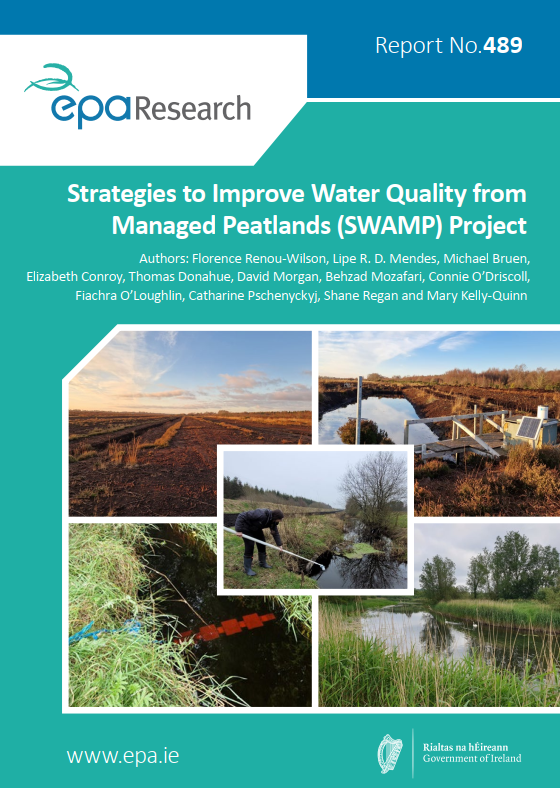
Research 489: Strategies to Improve Water Quality from Managed Peatlands (SWAMP) Project
Authors: Florence Renou-Wilson, Lipe R. D. Mendes, Michael Bruen, Elizabeth Conroy, Thomas Donahue, David Morgan, Behzad Mozafari, Connie O’Driscoll, Fiachra O’Loughlin, Catharine Pschenyckyj, Shane Regan and Mary Kelly-Quinn, July 2025
Year: 2025
The Strategies to Improve Water Quality from Managed Peatlands (SWAMP) research project aimed to address key knowledge gaps about water quality degradation in Ireland's peatland areas. This degradation is caused by decades of drainage for industrial and domestic peat extraction. The project reveals how long-term drainage for peat extraction and other land uses have negatively impacted Ireland's rivers and streams. Drained peatlands have leached harmful nutrients, acids, and carbon-rich water into these water bodies. The research focuses on identifying pollution hotspots, measuring the effects of peat soil drainage on water chemistry and aquatic biodiversity, assessing pollution prevention measures, and developing better hydrological models to predict the response of peatlands to drainage and restoration. These findings come at a crucial time as Ireland must address the specific challenges of complying with the Water Framework Directive and fulfilling the Nature Restoration Law.

Research 486: Proactive Optical Monitoring of Catchment Dissolved Organic Matter for Drinking Water Source Protection (PRODOM)
Authors: John Weatherill, Boris Droz, Elena Fernández-Pascual, Jean O’Dwyer, Emma Goslan, Connie O’Driscoll and Simon Harrison, May 2025
Year: 2025
In Ireland, approximately 82% of public water supplies originate from surface water catchments. This water requires disinfection with chlorine to inactivate pathogens and prevent the spread of waterborne disease. The presence of dissolved organic matter (DOM) in source waters can lead to the formation of potentially carcinogenic disinfection by-products (DBPs), such as trihalomethanes (THM4), of which Ireland has the highest number of reported exceedances in the EU in recent years. This research conducted detailed field and laboratory investigation in the River Lee catchment (Cork, Ireland), supported by predictive modelling using machine learning techniques, to gain more insights in the role of optically active DOM in DBP formation and forecasting. It highlights the value of UV-visible spectroscopy as a cost-effective and non-destructive technology suitable for proactive management of DOM in source water, with a high potential for aiding real-time process control at treatment plants.

Research 485: Specific Management and Robust Targeting of Riparian Buffer Zones
Authors: Daire Ó hUallacháin, Per-Erik Mellander, Simon Parker, Nikki Baggaley, Mark E. Wilkinson, Allan Lilly and Marc Stutter, April 2025
Year: 2025
With many of Ireland's surface waters classed as less than the minimum of “good ecological status” under the Water Framework Directive, this research project looked to support optimal targeting and management of riparian margins, in agricultural contexts, for effective management of rivers in Ireland. It delivers a riparian measures database summarising alternative measures for Irish conditions, evaluating their effectiveness and wider ecosystem service benefits. Core to the research is the “Right Measure, Right Place” concept, a key tenet of Ireland’s River Basin Management Plan (2022–2027). Tools were developed to identify locations for maximum impact, using landscape context to prioritise 16 identified mitigation measures. The project aims to help policymakers and other research projects expand beyond traditional approaches to achieve water quality objectives under policies like the Common Agricultural Policy and Water Framework Directive.

Research 484: Framework for Characterising Oligotrophic (3110 and 3160) Lakes Using Practical Methods and Assessment Tools
Authors: Heather T. Lally, Martin Gammell, Emma Gray, Giovanni Cappelli and Cilian Roden, April 2025
Year: 2025
Oligotrophic lake habitats, which are characterised by low accumulation of dissolved nutrient salts are protected freshwater habitats in Ireland. These habitats support limited life forms, mainly algae and macroinvertebrates. This research report, from the "Peat Lakes" project, looks at the potential of these organisms to help in characterising and conserving oligotrophic lakes using practical methods and assessment tools. It assesses and provides findings on water chemistry and data from plant communities, including macrophytes, algal communities (including desmids), and invertebrate communities from 24 water bodies within Atlantic blanket bog landscapes in the west of Ireland. The report makes several recommendations and provides relevant stakeholders from state agencies with important information for the conservation of small water bodies (area ≤ 0.01 km²), to support the monitoring of favourable conservation conditions in oligotrophic lake habitats, under the EU Habitats Directive.

Research 482: Mitigating Agricultural Impacts on Water Quality through Research and Knowledge Exchange
Authors: Mary Ryan, Cathal O’Donoghue, Denis O’Hora, Jenny McSharry, Pat Murphy, Noel Meehan, Karen Daly, Owen Fenton, Yuting Meng, Paula Cullen, Rossella Di Domenico, Thomas Moloney, LoriRae van Laren, Daniel Urban, Niall McLoughlin, Emma Byrne, Catherine Seale and Maura Farrell, March 2025
Year: 2025
This research report explores improving water quality affected by agricultural practices using a multi-disciplinary approach .It incorporated systems analysis of actors and incentives, spatial analysis on the effects of rural activity, analysis of factors impacting measure adoptions, and socio-economic and behavioural psychology studies to identify drivers of pro-environmental activity. Key findings highlight the necessity of localised solutions, the importance of farm advisors and local farming 'champions', collaboration among stakeholders, and providing knowledge and resources to farmers. It also finds that trust between advisors and farmers, upskilling advisors, and understanding the direct and indirect barriers to farm-level behaviour change are seen as crucial for fostering sustainable agricultural practices. The researchers highlights the importance of incentives and behavioural interventions to promote pro-environmental practices.

Research 480: PestMan: Pesticide Management for Better Water Quality
Authors: Mark G. Healy, Alma Siggins, Paraic C. Ryan, John McGinley, Jennifer Harmon O’Driscoll, Shane Scannell, Per Erik Mellander and Liam Morrison, March 2025
Year: 2025
With world populations increasing the use of pesticides has also increased to bolster crop yields and cater for global food demand. Pesticides released unintentionally from both the agricultural and urban sectors have the potential to enter non-target ecosystems and pose a threat to the environment and human health. The PestMan research project used a multidisciplinary approach, integrating soil processes, molecular biology, engineering, and quantitative risk assessment methodologies to address the environmental and human health impacts of pesticides. It sets out to understand the drivers and pressures of pesticide use, study their fate and persistence, evaluate their risks, and develop a cost-effective, passive remediation method to mitigate these issues. The research developed a multidisciplinary framework to understand and mitigate the environmental and human health impacts of pesticides, focusing on their movement, persistence, risks, and effective remediation strategies

Research 475: Effect-based Monitoring for Pharmaceutical Pollution in Ireland
Authors: Fiona Regan and Dylan O’Flynn, January 2025
Year: 2025
This research addressed the significant societal and environmental risks posed by active pharmaceutical ingredients (APIs) in water sources. Even at low concentrations these can affect wildlife and potentially humans. The report identifies the main sources of APIs and reveals that certain pharmaceutical compounds are consistently present at measurable concentrations, emphasising the importance of monitoring near waste water treatment plants and in surface waters both upstream and downstream. In addition, the project aimed to assess the effectiveness of ecotoxicology tests in determining the chronic effects of pharmaceuticals and measure toxicity, or modes of action using a battery of bioassays on individual pharmaceutical compounds and mixtures. Using this comprehensive approach, the research provides a deeper understanding of pharmaceutical pollution to inform strategies to mitigate its impact on the environment and public health.

Research 473: Coastal Lagoons: Ecology and Restoration (CLEAR)
Authors: Brendan O’Connor, Geoff Oliver, Tony Cawley, Cilian Roden, Philip Perrin, Rutger de Wit, Kevin McCaffrey and Aisha O’Connor, January 2025
Year: 2025
Lagoons of good conservation status are dominated by benthic macrophytes rather than phytoplankton blooms. Lady’s Island Lake in Wexford is one of Ireland’s largest lagoons, it is also one of our most eutrophic lagoons, this contrast with the 1980s when clear water was matched by a well-developed benthic sward of widgeon grass. This research conducted a suite of investigations into the reasons for the decline and compared the results with a less impacted saline lagoon. The results show severe degradation in Lady’s Island Lake with over 10 times higher chlorophyll a levels. Runoff of excessive nutrient inputs of nitrogen and possibly phosphorus from agriculture are identified as the main cause of eutrophication. A proposal to replace sea barrier breaching with a pipe also poses a serious risk to reducing lagoonal salinity. The research proposes a range of remedial measures to protect and improve the benthic quality of Lady’s Island Lake and other saline lagoons in Ireland.

Research 469: Public Health Impact of Exposure to Antibiotic Resistance in Recreational Waters (PIER)
Authors: Dearbháile Morris, Liam Burke, Sinéad Duane, Maeve Farrell, Alexandra Chueiri, Dmitry Brychkov, Anne Leonard, Francesca McDonagh, Louise O’Connor, Sabine Franklin, Christine Domegan, Áine McNamara, Regina Kiernan, Katharine Harkin, William Gaze, Easkey Britton, Diarmuid O’Donovan and Martin Cormican, November 2024
Year: 2024
With Antimicrobial resistance (AMR) recognised as one of the greatest challenges to human and animal health, it has major implications for our agriculture and food production systems, environment and economy. Using the One Health approach, which recognises the link between human, animal and environmental health, the PIER project focuses on furthering our understanding of the public health implications of environmental exposure to AMR and how this impacts the use of blue spaces, wellbeing and the quality of life. Using a multidisciplinary project team PIER gathered data on the relative risk of AMR colonisation following exposure in recreations waters, the persistence of AMR carriage in healthy individuals and created a stakeholder recreational water environment map to help identify feasible and impactful options to maximising use of our blue spaces. It highlights the need for guidelines on monitoring and reporting antimicrobial presence in bathing waters and year round monitoring.

Research 468: Managing Small Stream Networks for Improved Water Quality, Catchment Biodiversity and Ecosystem Services Protection
Authors: Mary Kelly-Quinn, Michael Bruen, Mike Bowes, Jens Carlsson, Edward Cox, Angela Gurnell, Sinéad Hogan, Ann-Marie Kelly, Marcin Penk, John O’Sullivan and Jeremy Piggott, November 2024
Year: 2024
Ireland has many commitments to both water quality and biodiversity under policies like the Water Framework Directive, national biodiversity plans, the Habitats Directive and the Nature Restoration Law. Considering these this research refocused attention on the Small Stream Network (SSNet) in terms of water quality management and policy. SSNet is the first large-scale research project in Ireland on first- and second-order streams to undertake investigations spanning hydrochemistry, multiple ecological elements and likely impact of climate change stressors. It advances knowledge on the role of small streams in water quality, biodiversity and ecosystem services and the pressures they face from diffuse and point source pollution. It recommends more water quality monitoring of small streams to help protect biodiversity and water quality further downstream, with priority protection given to areas with high regional biodiversity. Citizen science can potentially facilitate better monitoring.
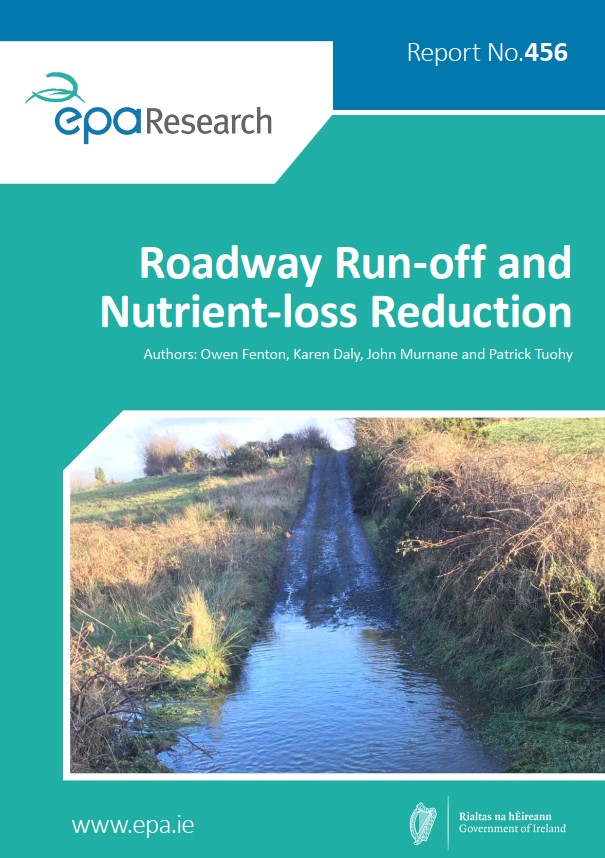
Research 456: Roadway Run-off and Nutrient-loss Reduction
Authors: Owen Fenton, Karen Daly, John Murnane and Patrick Tuohy, June 2024
Year: 2024
The Nitrates Directive aims to protect water quality across Europe by preventing nutrients from agricultural sources, including livestock manures and other fertilisers, from polluting ground and surface waters, and by promoting good farming practices. Ireland’s Nitrates Action Programme states “There shall be no direct runoff of soiled water from farm roadways to waters”. Despite existing regulation, there has been minimal research in Ireland pertaining to the source, content, pathway, mobilisation and impact of roadway runoff. The Roadrunner project reviewed mitigation measures to treat roadway runoff, developed an on-farm visual tool to find and document connectivity between roadway runoff and waters, and provided the evidence base to define roadway runoff as a unique sub-component of the nutrient transfer continuum.
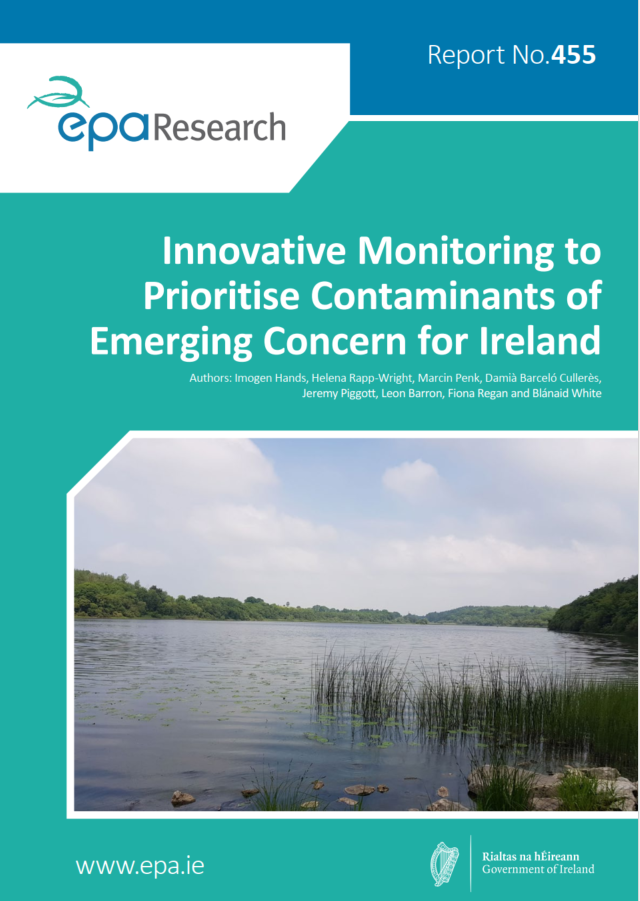
Research 455: Innovative Monitoring to Priorities Contaminants of Emerging Concern for Ireland (IMPACT)
Imogen Hands, Helena Rapp-Wright, Marcin Penk, Damià Barceló Cullerès, Jeremy Piggott, Leon Barron, Fiona Regan and Blánaid White, April 2024
Year: 2024
Contaminants of Emerging Concern (CECs) can be defined as “any synthetic or naturally occurring chemical or any microorganism that is not commonly monitored in the environment but has the potential to enter the environment and cause known or suspected adverse ecological and/or human health effects”. This research provides a comprehensive insight into the occurrence and fate of CECs in wastewater treatment effluent on entry to Irish receiving waters. Two wastewater treatment plants (WWTPs), one urban and one rural were monitored for one year to identify the temporal and spatial occurrence of more than 100 CECs in the aquatic environment and the WWTPs influents and effluents. This work allows contaminants that are not efficiently removed during treatment of municipal effluents to be highlighted and enables an evidence-based prioritisation list of CECs to be developed in Ireland.
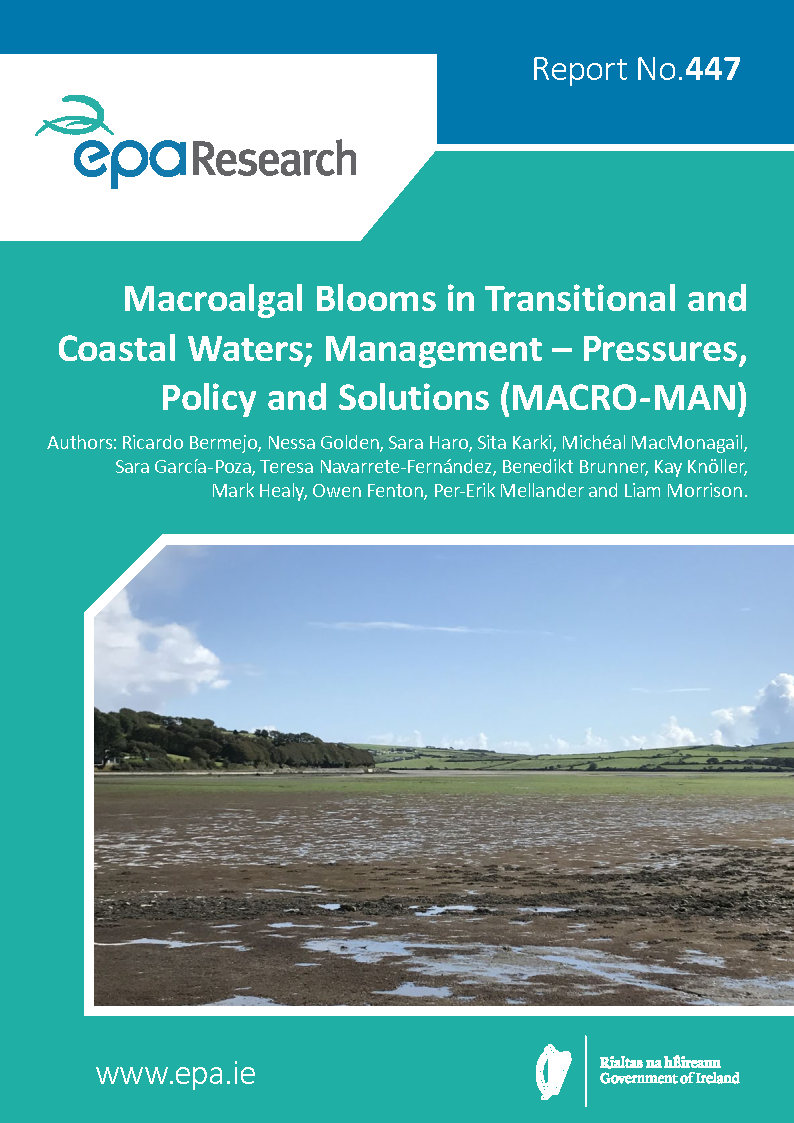
Research 447: Macroalgal Blooms in Transitional and Coastal Waters; Management – Pressures,Policy and Solutions (MACRO-MAN)
Authors: Ricardo Bermejo, Nessa Golden, Sara Haro, Sita Karki, Michéal MacMonagail,Sara García-Poza, Teresa Navarrete-Fernández, Benedikt Brunner, Kay Knöller,Mark Healy, Owen Fenton, Per-Erik Mellander and Liam Morrison., January 2024
Year: 2024
Eutrophication of waters and consequent algal blooms place significant pressure on marine ecosystems. Reducing the nutrient load of these waters is essential for ecosystem restoration. The MACRO-MAN project developed innovative methods to assess the environmental quality of Irish estuaries, and to identify drivers of and management strategies for macroalgal blooms. The potential risks associated with macroalgal blooms were considered in a global change context (e.g., climate change, emerging contaminants, biological invasions) in order to investigate the impact on ecosystem functioning and services provided by Irish estuaries. Using Earth Observation technologies, the project mapped the spatial and temporal distribution of brown, green and red macroalgal blooms in Irish estuaries, including the reconstruction of the invasion of a red Asian seaweed (Gracilaria vermiculophylla) in the Clonakilty estuary.
-Oct23-v1_Part1.jpg)
Research 446: CROSSDRO: Cross-sectoral Drought Impacts in Complex European Basins
Authors: Conor Murphy and Sam Grainger, January 2024
Year: 2024
Droughts are pervasive and hazardous events that impact multiple domains, including agriculture, water resource management, ecological management, infrastructure, waterway navigation and forestry. A drought in Ireland in 2018, had severe socio-economic and environmental impacts across sectors: agriculture suffered from reduced grass growth, fodder shortages and decreased crop yields, peatlands faced increased wildfire risk and ecological degradation and water management was challenging amid supply issues. In addition, canals, waterways, and rivers experienced weed growth, navigation problems, fishing restrictions and reduced fish health and forestry saw increased tree deaths, especially in peatland plantations. The CROSSDRO project collated a network of river flow gauges across Europe, covering the period 1962–2017, for the analysis of hydrological drought.
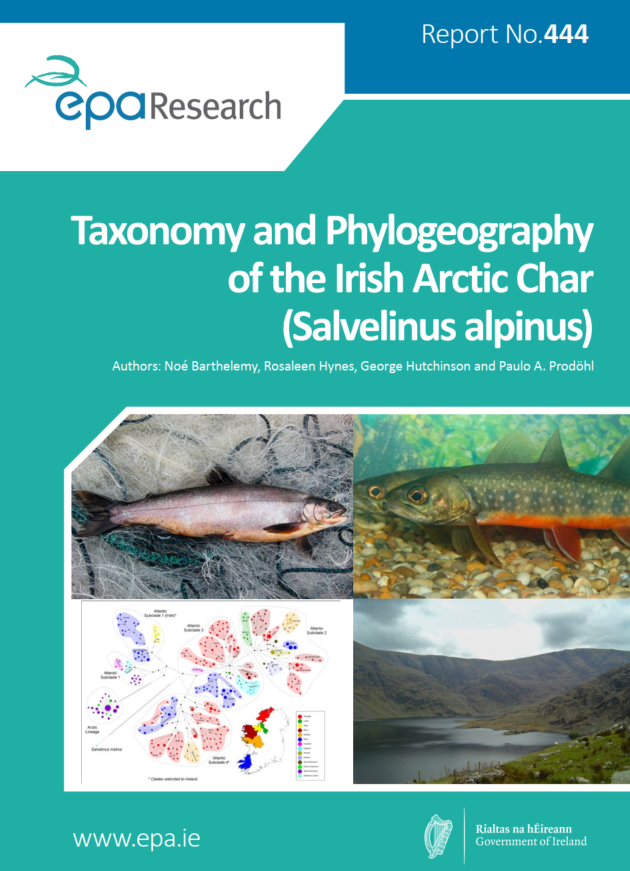
Research 444: Taxonomy and Phylogeography of the Irish Arctic Char (Salvelinus alpinus)
Authors: Noé Barthelemy, Rosaleen Hynes, George Hutchinson and Paulo A. Prodöhl, December 2023
Year: 2023
Salmonid Arctic char is a freshwater fish species vulnerable to low oxygen levels, rising temperatures associated with global warming, threats from invasive species, and water abstraction activities. There is an urgent need for effective conservation and management of Irish Arctic char, as it is recognised as “vulnerable” in the Irish Red Data Book. The study examined the role of scientific communication in influencing policymakers' decisions on conservation of this species.
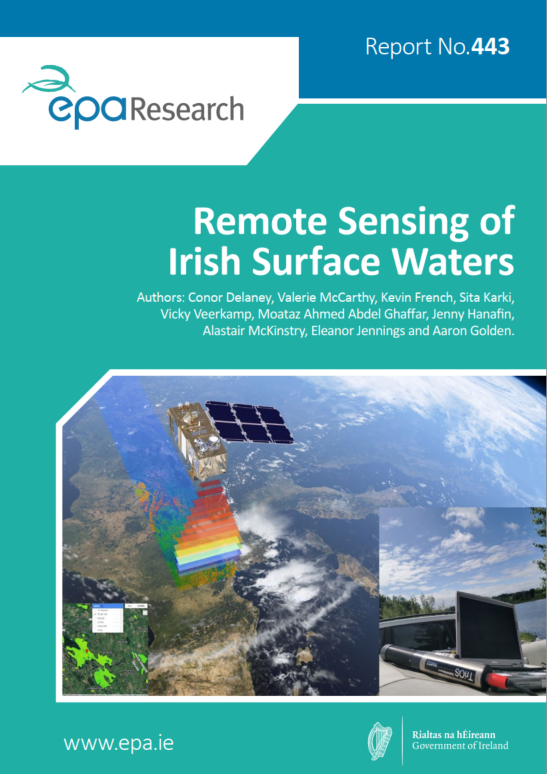
Research 443: Remote Sensing of Irish Surface Waters
Authors: Conor Delaney, Valerie McCarthy, Kevin French, Sita Karki, Vicky Veerkamp, Moataz Ahmed Abdel Ghaffar, Jenny Hanafin, Alastair McKinstry, Eleanor Jennings and Aaron Golden, November 2023
Year: 2023
Lakes, estuaries, and coastal waters are crucial for human well-being. Lakes are critical sources of drinking water, and support irrigation, fisheries, and aquaculture activities. These waters are also important for recreation and tourism and support high levels of biodiversity. The number and diversity of water bodies in Ireland makes regular in situ monitoring an acute challenge for regulatory authorities. Ireland has legally binding legislative obligations under the WFD. This project determined if the use of freely available Earth observation data from both the Copernicus and Landsat Earth observation programmes could offer a cost-effective and evidence-based means of remotely monitoring such water bodies in Ireland.
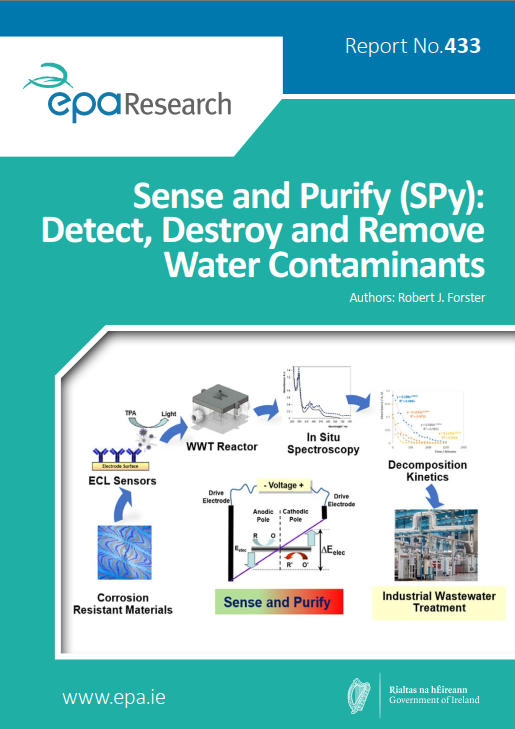
Research 433: Sense and Purify (SPy): Detect, Destroy and Remove Water Contaminants
Authors: Robert J. Forster, June 2023
Year: 2023
Many wastewater streams, such as those from the pharmaceutical and food industries or from municipal wastewater, for example, contain pollutants. The SPy project developed the eco-innovative ‘Sense and Purify’ (SPy) technology, which has significant advantages over traditional treatment processes, including low operations costs, significantly lower energy consumption, higher conversion efficiency, better effluent water quality and lower waste production.
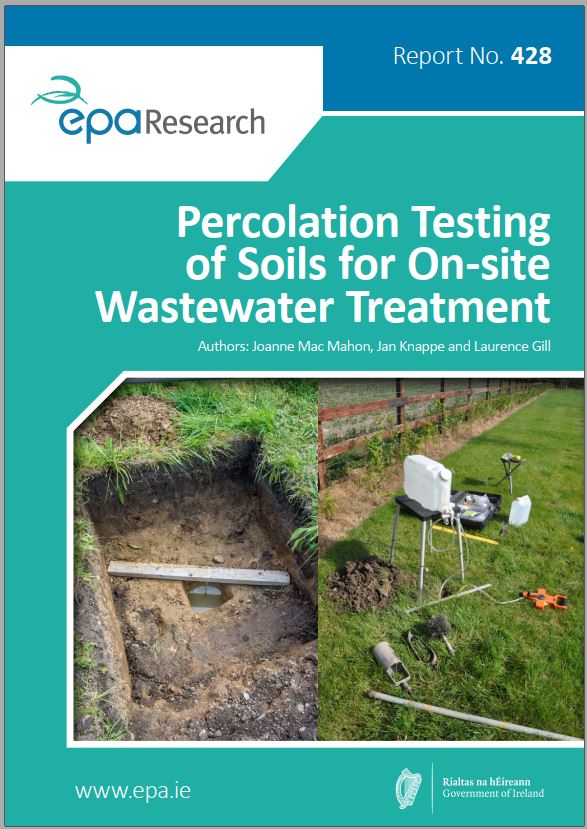
Research 428: Percolation Testing of Soils for On-site Wastewater Treatment
Authors: Joanne Mac Mahon, Jan Knappe and Laurence Gill, January 2023
Year: 2023
Estimation of soil permeability is a critical aspect of on-site wastewater treatment system design. The findings of this research identify a need to revise the currently available options in the Irish Code of Practice for estimating soil permeability for on-site wastewater system design. In this research, a correlation was developed between field saturated hydraulic conductivity (Kfs) and percolation time (T-values) across a full range of Irish soil texture data.